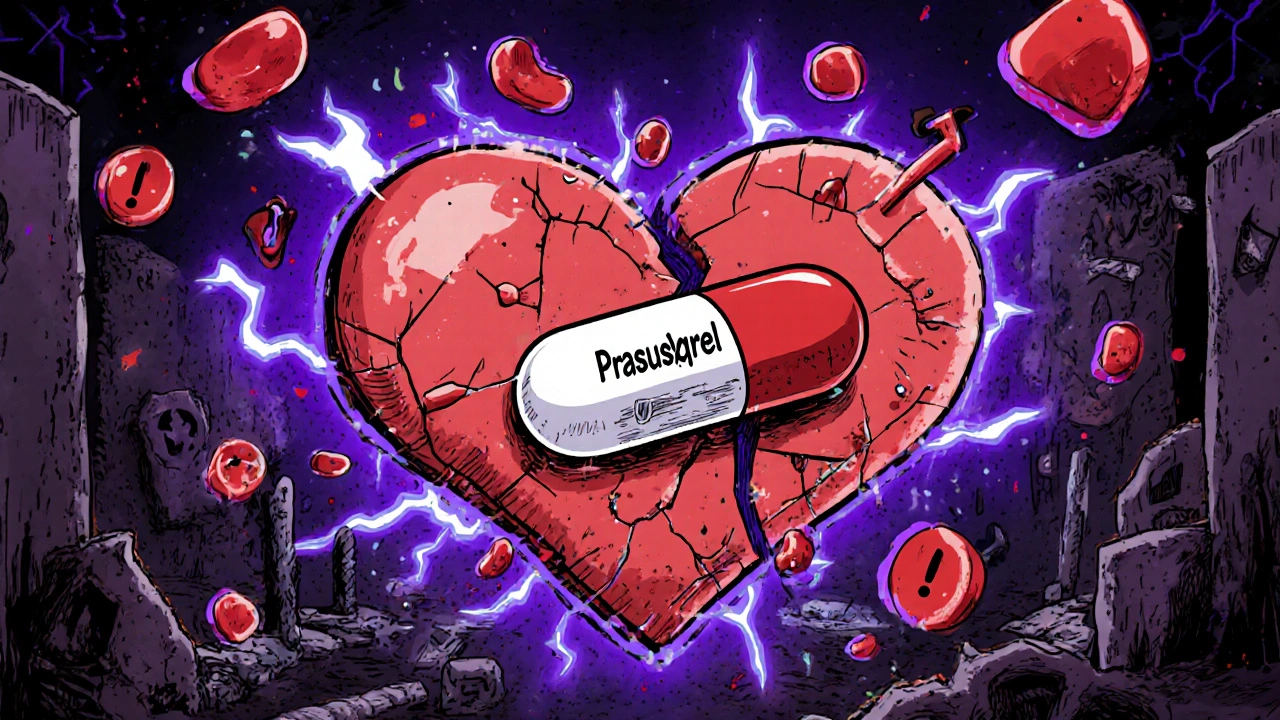Prasugrel is a prescription medication used to prevent blood clots in people who have had a heart attack or severe chest pain due to reduced blood flow to the heart. It’s not a drug you take for general health-it’s for serious, time-sensitive heart conditions. If you’ve had a stent placed after a heart attack or unstable angina, your doctor may have prescribed prasugrel. It works fast, it works hard, and it carries real risks. Understanding how it fits into your treatment plan can mean the difference between another clot and staying healthy.
How Prasugrel Stops Clots Before They Start
Prasugrel belongs to a class of drugs called P2Y12 inhibitors. These drugs block a specific receptor on platelets-the tiny blood cells that stick together to form clots. When you have a heart attack, plaque in your arteries ruptures, and your body tries to patch it by clumping platelets together. That’s dangerous. A clot can block blood flow to your heart or brain, causing more damage.
Prasugrel stops those platelets from sticking. It’s more potent than older drugs like clopidogrel. Studies show it reduces the chance of another heart attack, stroke, or death by about 19% in high-risk patients. That’s not a small gain. But it’s not magic. It only works if you take it exactly as prescribed.
Who Gets Prescribed Prasugrel?
Prasugrel isn’t for everyone with heart disease. It’s typically given to patients who:
- Had a heart attack (acute coronary syndrome)
- Underwent angioplasty with stent placement
- Are at high risk for another clot
Doctors choose prasugrel over clopidogrel when the risk of clotting is high and the patient is unlikely to have bleeding complications. It’s often used in younger patients, those with diabetes, or those who had a clot despite taking clopidogrel.
But if you’re over 75, weigh less than 60 kg (132 lbs), or have a history of stroke or bleeding, prasugrel is usually avoided. The risk of serious bleeding outweighs the benefit in these cases.
How It Compares to Clopidogrel and Ticagrelor
Prasugrel isn’t the only antiplatelet drug on the market. Two others are commonly used: clopidogrel and ticagrelor. Here’s how they stack up:
| Drug | Onset of Action | Effectiveness (Reduces Clot Risk) | Bleeding Risk | Dosing |
|---|---|---|---|---|
| Prasugrel | 30-60 minutes | High | Higher than clopidogrel | Once daily, 10 mg (5 mg if under 60 kg) |
| Clopidogrel | 2-8 hours | Moderate | Lower | Once daily, 75 mg |
| Ticagrelor | 30 minutes | High | Similar to prasugrel | Twice daily, 90 mg |
Prasugrel works faster than clopidogrel and is more reliable in people who don’t respond well to it. But ticagrelor has a similar effectiveness and doesn’t require liver activation like prasugrel does. That means ticagrelor might be better for patients with liver issues. The choice depends on your age, weight, medical history, and how your body responds.
Side Effects and Risks
Prasugrel’s biggest risk is bleeding. This isn’t just nosebleeds or bruising. It can mean internal bleeding-stomach, brain, or after surgery. About 4% of patients on prasugrel have serious bleeding events within a year. That’s why you shouldn’t stop taking it without talking to your doctor. Stopping suddenly can cause a clot to form right away.
Other side effects include:
- Headache
- Dizziness
- Nausea
- Shortness of breath
If you notice blood in your stool, vomit that looks like coffee grounds, or sudden weakness on one side of your body, get help immediately. These could be signs of internal bleeding or stroke.

What You Need to Know Before Taking Prasugrel
Prasugrel doesn’t play nice with other drugs. Here’s what you need to avoid or adjust:
- NSAIDs like ibuprofen or naproxen: Increase bleeding risk. Use acetaminophen instead for pain.
- Warfarin or other blood thinners: Combining them with prasugrel is dangerous unless strictly supervised.
- Proton pump inhibitors (PPIs) like omeprazole: Some studies suggest they might reduce prasugrel’s effect. Your doctor may choose pantoprazole or famotidine instead.
Also, tell any doctor or dentist you’re on prasugrel before any surgery or dental work. You might need to pause it 5-7 days before, but never without medical advice.
How Long Do You Take It?
Most people take prasugrel for at least 12 months after a heart attack or stent placement. Some stay on it longer if their risk remains high. But the longer you take it, the higher the bleeding risk. Your doctor will reassess your balance of risk and benefit every few months.
There’s no fixed rule. A 58-year-old man with diabetes and a stent might stay on it for years. A 72-year-old woman with a history of stomach ulcers might switch to clopidogrel after six months.
What If You Miss a Dose?
If you forget a dose, take it as soon as you remember. But if it’s almost time for your next dose, skip the missed one. Don’t double up. Taking too much increases bleeding risk without adding protection.
Set a daily alarm. Keep a pill organizer. Write it on your calendar. Missing doses is one of the most common reasons people end up back in the hospital with another clot.

Prasugrel and Lifestyle
Medication alone won’t fix your heart health. Prasugrel works best when paired with:
- Quitting smoking
- Eating a low-sodium, heart-healthy diet
- Regular walking or light exercise
- Controlling blood pressure and cholesterol
Studies show patients who combine prasugrel with lifestyle changes cut their risk of another heart event by more than half compared to those who only take the drug.
Frequently Asked Questions
Is prasugrel the same as aspirin?
No. Aspirin works by blocking a different pathway in platelets. Most people on prasugrel also take low-dose aspirin (75-100 mg daily) because the two work together. Prasugrel targets the P2Y12 receptor, while aspirin inhibits COX-1. Together, they provide stronger protection against clots.
Can I drink alcohol while taking prasugrel?
Moderate alcohol is usually okay-one drink a day for women, two for men. But heavy drinking increases bleeding risk and can raise blood pressure. It also interacts with other heart medications. If you’re unsure, talk to your doctor.
Does prasugrel cause weight gain?
No. Prasugrel doesn’t directly affect metabolism or appetite. If you’ve gained weight since starting it, it’s likely due to reduced activity after a heart event or changes in diet. Focus on moving more and eating well.
Is there a generic version of prasugrel?
Yes. Generic prasugrel became available in the UK and US in 2022. It’s just as effective as the brand-name version (Effient) and costs significantly less. Ask your pharmacist if you’re still getting the brand.
What happens if I stop prasugrel too soon?
Stopping early increases your risk of stent clotting, heart attack, or death. The highest risk is in the first 30 days after stopping. Never stop without talking to your cardiologist. If you’re having side effects, there are other options-don’t quit cold turkey.
What Comes Next?
If you’re on prasugrel, your next steps are simple but critical: take it daily, watch for bleeding signs, avoid NSAIDs, and keep your follow-up appointments. Don’t assume you’re fine just because you feel okay. Clots don’t always come with warning signs.
Ask your doctor for a written plan: when to stop, when to switch, what symptoms to report. Keep a list of all your meds in your wallet. Make sure your family knows you’re on a blood thinner in case of emergency.
Prasugrel isn’t a cure. It’s a tool. Used right, it gives you more time-more walks, more meals with family, more days without fear. Used wrong, it can cost you everything. Stay informed. Stay careful. Your heart is counting on it.






